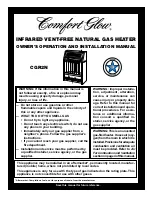
Date Printed: February 15, 2008
10
Version 1.01
When selecting wood for your Blaze King stove it is preferable that you use seasoned wood. Dry,
seasoned wood will burn cleaner and produce less creosote. Dry or small pieces of fuel will provide a
hotter fire. Larger pieces can be used to provide a longer burn time.
CAUTION
; Do not place wood fuel within the space heater installation clearances or within the space
required for wood loading and ash removal.
DISPOSAL OF ASHES
Ashes should be placed in a metal container with a tight fitting lid. The closed container of ashes
should be placed on a noncombustible floor or on the ground, well away from all combustible
materials, pending final disposal. If the ashes are disposed of by burial in soil or otherwise locally
dispersed, they should be retained in the closed container until all cinders have thoroughly cooled.
WARNING
REMOVE ASHES ONLY WHEN THEY ARE COLD. NEVER STORE HOT ASHES IN A GARAGE
OR BASEMENT. HOT ASHES WILL GENERATE CARBON MONOXIDE AND/OR FLAMMABLE
GASES. THESE GASES MAY CAUSE SUFFOCATION.
CHIMNEYS
The use of make-shift chimney installation is not allowed.
Before connecting any wood-burning unit to an existing chimney, inspect the chimney to be sure it is
in good condition. There should be no cracks or holes. Often it is impossible to see these from the
outside.
A certified chimney sweep should inspect your chimney and give you an accurate
assessment of its condition. The cross-section area must not be less than that of the flue collar.
Relining or rebuilding may be necessary to make a masonry chimney safe. A proper chimney is most
important for safe, satisfactory operation of any wood heating system.
Inspect the chimney and chimney connector at least twice each month during the heating season.
Any leak must be repaired. A chimney fire or deterioration can enlarge the hole. This will admit more
air and cause exhaust gasses to condense and form creosote. Patches of creosote in your chimney
indicate that such leaks are present.
CREOSOTE and SOOT
When wood is burned slowly, it produces tar and other organic vapors which combine with expelled
moisture to form creosote.
As a result, creosote residue accumulates on the flue lining.
When
ignited, this creosote makes an extremely hot fire.
The chimney and chimney connector should be inspected at least twice each month during the
heating season to determine if a creosote or soot build-up has occurred. If creosote has accumulated
it should be removed to reduce the risk of a chimney fire.
Building a small intense fire in your stove is preferable to having a large smoldering one as creosote
vapors condense in the relatively cool chimney flue of a slow-burning fire.
Never intentionally start a chimney fire to clean the flue.











































